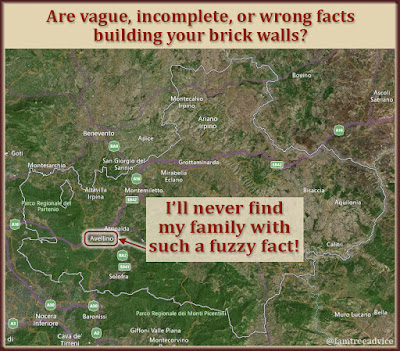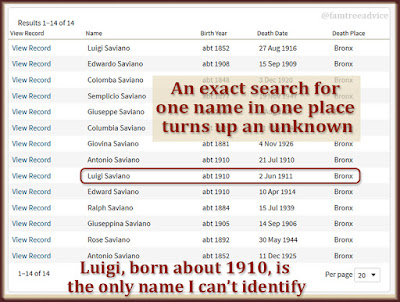If you think my latest project is crazy, allow me to prove you wrong.
I shamelessly told you about my latest obsession. I'm renaming all the files in my collection of Italian vital records. By adding the name of the person its about to the file name, I create a searchable database on my computer.
I still need to rename the death files from 1845–1858, which I'll complete this weekend. But I wanted to show you an example of how well this ambitious plan pays off.
I opened my family tree and focused on my dad's ancestors. Seventy-five percent of his ancestors came from the town I'm working on, Colle Sannita, Italy. I had to climb a few generations because the "younger" ancestors died at a time when I have no death records.
As my first subject, I'm choosing my 5th great grandmother Orsola Mascia. I know Orsola was born in 1770 because I found records for 5 of her children that helped me set her age. And I know she married my 5th great grandfather Giuseppe d'Emilia. But I don't know when Orsola died or who her parents were.
Let's see what we can do about that.
I have a main folder on my computer for the town of Colle Sannita. Inside that are 225 folders of birth, marriage, and death records sorted by year. Starting at the town's folder, I enter the name Orsola Mascia in the folder's search box and press enter. I get 8 results. A small number is easier to sift through, so I'm happy with that.
 |
| A quick search on my computer instantly found my 5th great grandmother. |
You can see from these results that the best matches are at the top. Exact matches come first. As you go down the list, you'll see that some results contain "Orsola" and "Mascia", but not together.
This is an important point. You can do an exact search by adding quotation marks ("Orsola Mascia"). But what if her full name was Orsola Maria Mascia? I wouldn't get the right results. So I always keep the search a bit looser.
When I double-click the first result, I'm hoping to see that she's married to Giuseppe d'Emilia. He's my 5th great grandfather.
And it is her! My file renaming project is paying off. I learned that:
- Orsola Mascia died on 4 March 1838 in Colle Sannita.
- She was 66 years old and also born in Colle Sannita.
- Her parents were Saverio Mascia and Prudenzia Zeolla.
- Her parents were both dead before this date. I know that because I see the word "fu" before their names. That means was, as in, this was her father, but he's dead now. (See "How to Read an Italian Death Record".)
What a victory! I found the names of another set of my 6th great grandparents: Saverio and Prudenzia. (Cue the Beatles' "Dear Prudence".) Because of Orsola's birth year, I know they were born no later than the mid 1740s.
 |
| This key record was hiding in a batch of files...until I renamed it. |
Now that I've made this discovery—and so easily!—let's walk through all the steps I need to take next.
- Add the new facts to Family Tree Maker:
- Add Orsola's place of birth, and her date and place of death.
- Add her parent's names and estimated birth year (25 years before Orsola was born) and death dates of "Bef. 4 Mar 1838".
- Get the document image ready for Family Tree Maker.
- Crop the image in Photoshop and save it to my FamilyTree/Certificates folder.
- Right-click the cropped file on my computer and choose Properties. Then add a title and description to this image's details. The description includes the exact URL where anyone can find this document online. (For more detail, see "How to Increase the Value of Your Family Tree Images".)
- Drag the image into Family Tree Maker. It retains and displays the facts I added.
- Since it's my only document for Orsola, I'll make it her profile image.
- Make note of this find in my Document Tracker. I record every document in my family tree in one Excel file.
- Add her parents to my grandparent chart. Her Ahnentafel number is 133, so her father and mother are 266 (double hers) and 267 (double hers + 1), respectively. This tells me exactly where to put her parents in the grandparent chart. (See "3 Things to Do with Ahnentafel Numbers".) Download a grandparent chart for your family tree. It's color-coded for your 4 grandparents and includes Ahnentafel numbers.
 |
| My newly found 6th great grandparents now take their place in my grandparent chart. |
That was big. A breakthrough! I'm eager to search more of my ancestors with missing dates and parents.
If your people are from a small town, and you can find vital records, go get 'em! I hope you'll have as much success as I know I will.



















